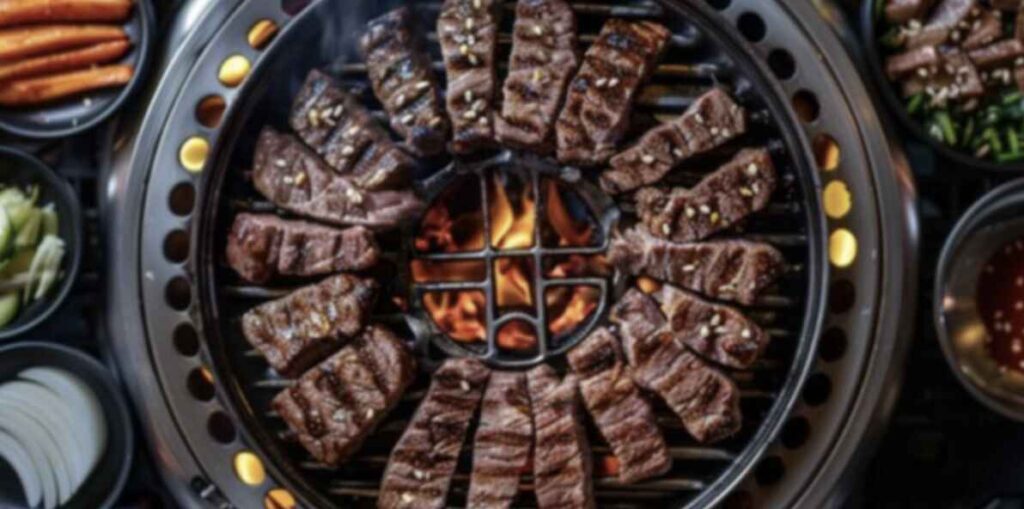A Night to Remember: The Magic of Korean Barbecue
Imagine this: The air is thick with the aroma of sizzling meat, the chatter of friends fills the room, and in front of you, a glowing grill promises a feast unlike any other. Welcome to the world of Korean barbecue (KBBQ), where every bite tells a story. But what makes this experience so unforgettable? Let’s step into the heart of a KBBQ night and uncover the ingredients that bring it to life.
Table of Contents
The Star of the Grill: Meat That Melts in Your Mouth

“Alright, who’s ready to feast?” your host grins, unveiling a platter of beautifully marbled meats. “This is where the magic begins.”
- Galbi (갈비) – Beef Short Ribs: Sweet, savory, and fall-off-the-bone tender after soaking in a rich marinade.
- Bulgogi (불고기) – Thinly Sliced Beef: A balance of soy sauce, sugar, garlic, and sesame oil that caramelizes perfectly on the grill.
- Samgyeopsal (삼겹살) – Pork Belly: Unmarinated, thick-cut, and meant to be crisped to perfection.
- Dak Galbi (닭갈비) – Spicy Chicken: Coated in a fiery gochujang marinade, promising a punch of flavor.
- Chadolbaegi (차돌박이) – Brisket: Thin, delicate slices that cook in seconds, dripping flavor onto the flames.
“Flip it only once!” your host warns. “Let the sear do its work.”
The Secret Elixirs: Marinades & Sauces
Before the first bite, you dip your meat into a shimmering sauce. “This,” they whisper, “is where the soul of KBBQ lives.”
| Ingredient | Why It Matters |
|---|---|
| Soy Sauce | A salty, umami-rich base for marinades. |
| Gochujang (Korean Chili Paste) | Sweet, spicy, and deeply flavorful. |
| Sesame Oil | Nutty, aromatic, and essential for dipping. |
| Garlic & Ginger | A punch of bold, warm spice. |
| Pear or Apple Puree | A secret tenderizer that adds sweetness. |
| Honey or Brown Sugar | For that perfect caramelization. |
| Doenjang (Fermented Soybean Paste) | Deep, earthy umami that lingers. |
The Sidekicks: Banchan (Side Dishes) That Steal the Show
Suddenly, the table fills with tiny plates of vibrant dishes. “Don’t ignore these!” your host laughs. “Banchan makes every bite better.”
- Kimchi (김치): Spicy, fermented cabbage that cuts through the richness.
- Gyeranjjim (계란찜): A fluffy, steaming egg custard.
- Japchae (잡채): Glass noodles kissed with sesame oil.
- Kongnamul (콩나물): Fresh, crunchy soybean sprouts.
- Pickled Radish: Sweet and tangy—refreshing between bites.
“You can ask for refills!” your host winks. “It’s part of the fun.”
Exclusive Chef Tips for the Ultimate KBBQ
- Use Charcoal for an Authentic Flavor: Gas grills work, but charcoal adds a smoky depth that makes a huge difference.
- Preheat Your Grill Properly: A hot grill ensures perfect searing and prevents meat from sticking.
- Oil the Grill Grate with a Cut Onion: It naturally adds flavor while keeping meat from sticking.
- Layer Your Bites: Stack grilled meat, kimchi, and a sliver of garlic in a lettuce wrap for a flavor explosion.
- Rest the Meat Before Eating: Let it sit for a few moments after grilling to retain juices.
- Experiment with Marinades: Try adding a splash of Coke or beer to your bulgogi marinade for an extra tender texture.
FAQs About Korean BBQ
- What’s the best meat for beginners? Samgyeopsal (pork belly) is great because it’s easy to cook and pairs well with many flavors.
- Can I make KBBQ at home without a special grill? Yes! A cast-iron skillet or tabletop electric grill works just fine.
- How do I avoid burning marinated meats? Cook them over medium heat to prevent sugar-based marinades from charring too quickly.
- What’s the proper way to eat KBBQ? Wrap your grilled meat in lettuce with banchan and dipping sauces—it’s called “ssam” style.
- What drinks pair best with KBBQ? Soju and beer are classic choices, but makgeolli and even non-alcoholic Sikhye are great options too!
Your KBBQ Challenge!

Ready to put your skills to the test? Gather your friends and host a Korean BBQ night at home! Try different marinades, grill techniques, and side dishes. Snap a photo and share your masterpiece online with #MyKBBQFeast!
Now it’s your turn! Gather your friends, fire up the grill, and create your own unforgettable KBBQ night!

